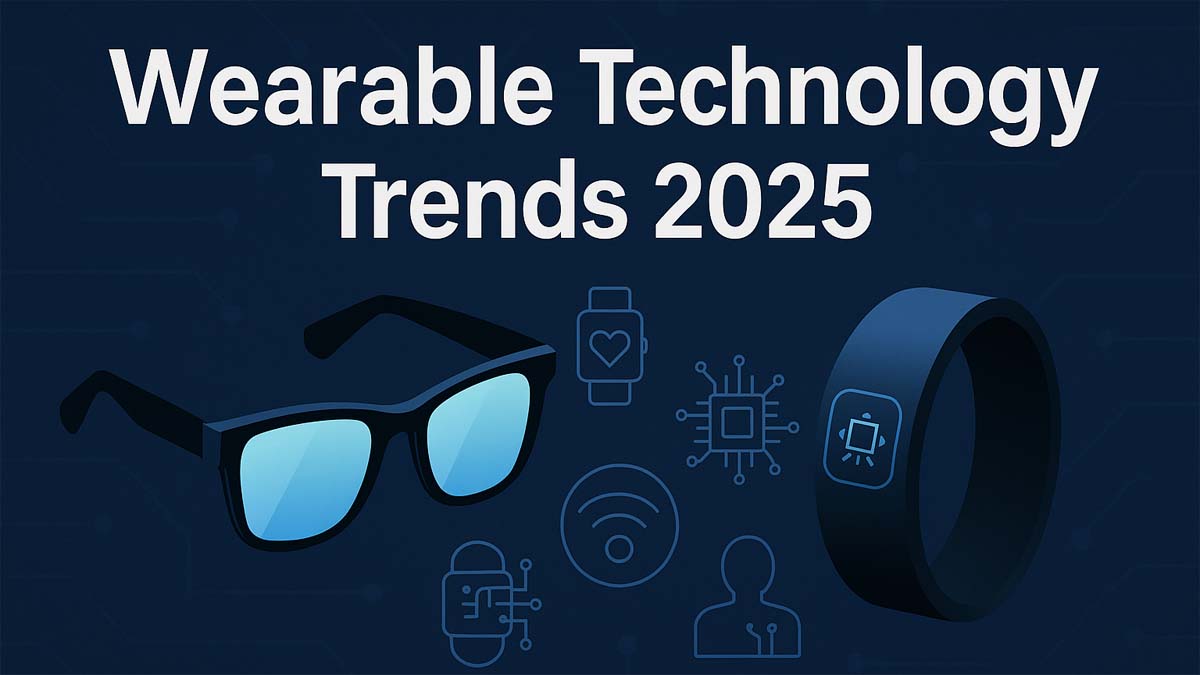Wearable Technology Trends 2025
Wearable devices have evolved far beyond simple fitness trackers. In 2025, wearable technology trends are ushering in a new era of smart, connected devices that not only monitor health but become an integral part of daily life. From smart rings and AR glasses to textile-embedded sensors and advanced health wearables, the market is set to transform how we interact with technology and our bodies.
Market Outlook & Growth
The global wearables market continues to expand rapidly. The market size for wearable technology was estimated at USD 84.2 billion in 2024 and is expected to grow at a compound annual growth rate (CAGR) of approximately 13.6 % from 2025 to 2030. Grand View Research+2Fortune Business Insights+2 Another source projects growth from USD 86.78 billion in 2025 to USD 191.58 billion by 2032. Fortune Business Insights+1 These figures demonstrate strong demand across consumer electronics, healthcare, fitness, and industrial applications.
North America holds a dominant share in this market, while Asia-Pacific and Europe are growing strongly, driven by demand for health and IoT wearables. Grand View Research+1
What’s Driving the 2025 Shift?
Several key forces are driving the next wave of wearables:
1. Health & Wellness Integration
Wearables are increasingly used for health monitoring, not just fitness tracking. Advanced sensors, AI-powered analytics, and connectivity allow devices to detect patterns and provide proactive health insights. For example, smart rings, smart clothing and implantables are emerging in healthcare. Sermo+1
2. Seamless & Invisible Tech
The trend is toward devices that blend into everyday life. Smart jewelry, clothing with embedded sensors, and minimal form factor wearables are gaining traction. Users expect technology that doesn’t feel intrusive but is present when needed. 42Gears Mobility Systems+1
3. Advanced Connectivity & IoT Integration
Wearables are becoming nodes in the larger IoT network. With faster connectivity (including 5G/6G), wearables can share data in real time, making them more useful for health management, smart home integration, and enterprise use cases. Fortune Business Insights+1
4. Programmable Wearables & AR/VR
Augmented reality (AR) and mixed reality (MR) wearables are gaining more attention. Devices like AR glasses or wrist displays are moving closer to mainstream adoption, and wearable tech is evolving toward providing immersive experiences. Reuters+1
5. Sustainability & Material Innovation
Wearables are also getting smarter in design: flexible fabrics, e-textiles, and energy-efficient sensors are enabling device designs that are lighter, washable and more user-friendly. LinkedIn
Top Wearable Technology Trends to Watch in 2025
Smart Rings & Minimal Hardware
Smart rings like Oura have demonstrated that health tracking and notifications can be delivered in form factors much smaller than watches. These rings offer sleep tracking, heart rate variability, and more, with less bulk. The trend is toward discreet wearables. 42Gears Mobility Systems+1
Smart Clothing & Embedded Sensors
Textile-based wearables (e-textiles) are emerging as key technology. Clothing that monitors health, posture or movement and communicates with apps is real. Research is growing in wireless charging for textile wearables. arXiv+1
AR/Smart Glasses
Major tech firms are launching AR or smart glasses that combine AI, display, and wearable form factor. For example, Meta Platforms launched new smart glasses with built-in display in 2025. Reuters These glasses will serve as wearable computing platforms beyond smartphone tethering. The challenge remains cost, battery, and form factor. Business Insider
Health & Clinical Wearables
Wearables are now addressing medical / clinical use cases: early disease detection, chronic condition monitoring, implanted sensors, continuous biometric monitoring. The convergence of healthcare and wearables is a defining trend of 2025. Sermo+1
Wearables as Payment & Authentication Devices
Wearables are also being integrated as payment devices or authentication tokens, further embedding them into everyday life and financial systems. PR Newswire
Implications for Consumers & Businesses
For Consumers
-
Convenience: Wearables will provide seamless assistance, notifications, health insights, context-aware alerts.
-
Wellness: More sophisticated tracking will allow users to manage health proactively.
-
Privacy: As wearables collect more personal data, consumers will demand stronger privacy controls and transparency.
For Businesses & Industries
-
Workforce: Employers may adopt wearables for safety monitoring, productivity tracking, and wellness programs.
-
Healthcare: Providers will rely on wearables for remote monitoring and early diagnosis.
-
Retail & IoT: Wearables will integrate with smart home and smart lifestyle systems, forming part of larger connected ecosystems.
Challenges Ahead
Despite exciting growth, wearable technology trends in 2025 also face hurdles:
-
Battery life & power consumption remain key constraints, especially for always-on devices. Designers continue to work on low-power sensors and fabric-based power solutions. PR Newswire+1
-
Privacy and regulation: With more health data being collected, regulatory frameworks must evolve. A recent study underscores the divide between wellness devices and regulated medical devices. arXiv
-
Cost & adoption: Some AR wearables or smart glasses are still cost-prohibitive, limiting mainstream adoption. Business Insider
-
User experience: Wearables must provide tangible benefit without being intrusive; otherwise, adoption will stall.
Future Outlook & Predictions
By 2027-2030, expect several developments:
-
Smart glasses with full AR capabilities and independent connectivity
-
Wearable devices embedded in clothing and accessories that are indistinguishable from regular garments
-
Health wearables moving into mainstream medical device territory with regulatory approval
-
Wearables functioning as hubs in smart homes and offices, not just personal devices
-
Broader adoption of wearable payments, authentication and identity verification
According to market research, the wearable technology market could reach USD 191.58 billion by 2032, reflecting the long tail of investment and innovation. Fortune Business Insights
What to Do Now
If you’re considering wearables, either buying for personal use or incorporating them into business strategy—here are steps to consider:
-
Identify the core benefit you want (health tracking, productivity, payments).
-
Choose a device with ecosystem support (apps, updates, compatibility).
-
Consider privacy and data security, select reputable brands with clear policies.
-
Stay informed about emerging trends and upcoming devices, especially if you want best-in-class features.
-
For businesses, pilot wearable projects with clear ROI metrics (employee safety, wellness, cost savings).
Final Thoughts
In 2025, wearable devices are no longer optional luxury gadgets, they are pivotal elements of personal and professional technology. The wearable technology trends 2025 show that devices will become smarter, integrated, and indispensable in daily life. From smart rings and AR glasses to health-monitoring apparel and payment-enabled wearables, the future is at our wrists, in our glasses, and woven into our clothes.
For consumers, this means richer experiences and more control over health and connectivity. For businesses, it means new opportunities to rethink how devices fit into lifestyle and operations. As the market continues to expand, the winners will be those who combine meaningful functionality, strong ecosystem support, and respect for privacy.


